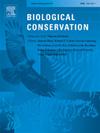Five recommendations to fill the blank space in indicators at local and short-term scales
IF 4.9
1区 环境科学与生态学
Q1 BIODIVERSITY CONSERVATION
引用次数: 0
Abstract
The year 2030 is rapidly approaching. Building, monitoring, and reporting indicators to evaluate the 2030 targets in the Kunming-Montreal Global Biodiversity Framework (GBF) is a major challenge that requires, at minimum, nations to assess their progress at least once within the next five years. To effectively monitor this progress, we need indicators that capture fast-paced, on-the-ground biodiversity change at the scale of conservation action, alongside slower, more diffuse biodiversity trends at national scales. We argue that the focus on monitoring global and national biodiversity changes has left a gap in our ability to capture fine-scale changes and therefore our progress towards the GBF's Goal A targets. To fill this blank space, we recommend integrating locally sourced data into biodiversity indicators, testing indicator performance at relevant spatiotemporal scales, monitoring locally and strategically to detect changes across scales, and developing indicators of fine-scale biodiversity changes.
求助全文
约1分钟内获得全文
求助全文
来源期刊

Biological Conservation
环境科学-环境科学
CiteScore
10.20
自引率
3.40%
发文量
295
审稿时长
61 days
期刊介绍:
Biological Conservation is an international leading journal in the discipline of conservation biology. The journal publishes articles spanning a diverse range of fields that contribute to the biological, sociological, and economic dimensions of conservation and natural resource management. The primary aim of Biological Conservation is the publication of high-quality papers that advance the science and practice of conservation, or which demonstrate the application of conservation principles for natural resource management and policy. Therefore it will be of interest to a broad international readership.
 求助内容:
求助内容: 应助结果提醒方式:
应助结果提醒方式:


